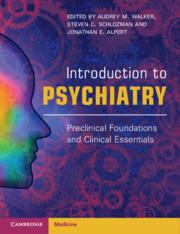Book contents
- Introduction to Psychiatry
- Introduction to Psychiatry
- Copyright page
- Contents
- Contributors
- 1 Introduction
- 2 Clinical Neuroscience
- 3 Introduction to the Patient Interview
- 4 Mood Disorders
- 5 Schizophrenia Spectrum and Other Psychotic Disorders
- 6 Anxiety Disorders
- 7 Obsessive-Compulsive and Related Disorders
- 8 Disorders Related to Stress and Trauma
- 9 Substance Use Disorders
- 10 Personality Disorders
- 11 Neurocognitive Disorders
- 12 Feeding and Eating Disorders
- 13 Child Psychiatry and Neurodevelopmental Disorders
- 14 Sleep Disorders
- 15 Psychopharmacology and Neurotherapeutics
- 16 Psychosocial Interventions
- 17 Psychiatric Evaluation in the Medical Setting
- 18 Psychiatry of Gender and Sexuality
- 19 Health Policy and Population Health in Behavioral Health Care in the United States
- 20 Global Health and Mental Health Care Delivery in Low-Resource Settings
- Index
- References
9 - Substance Use Disorders
Published online by Cambridge University Press: 22 July 2021
- Introduction to Psychiatry
- Introduction to Psychiatry
- Copyright page
- Contents
- Contributors
- 1 Introduction
- 2 Clinical Neuroscience
- 3 Introduction to the Patient Interview
- 4 Mood Disorders
- 5 Schizophrenia Spectrum and Other Psychotic Disorders
- 6 Anxiety Disorders
- 7 Obsessive-Compulsive and Related Disorders
- 8 Disorders Related to Stress and Trauma
- 9 Substance Use Disorders
- 10 Personality Disorders
- 11 Neurocognitive Disorders
- 12 Feeding and Eating Disorders
- 13 Child Psychiatry and Neurodevelopmental Disorders
- 14 Sleep Disorders
- 15 Psychopharmacology and Neurotherapeutics
- 16 Psychosocial Interventions
- 17 Psychiatric Evaluation in the Medical Setting
- 18 Psychiatry of Gender and Sexuality
- 19 Health Policy and Population Health in Behavioral Health Care in the United States
- 20 Global Health and Mental Health Care Delivery in Low-Resource Settings
- Index
- References
Summary
Substance use disorders are highly prevalent, affecting millions of Americans directly (social, occupational, and health problems) and indirectly (billions of dollars in health care costs and lost revenues due to disability). This section briefly introduces the chemical classification and neurobehavioral properties of the most commonly misused substances.
- Type
- Chapter
- Information
- Introduction to PsychiatryPreclinical Foundations and Clinical Essentials, pp. 179 - 232Publisher: Cambridge University PressPrint publication year: 2021



